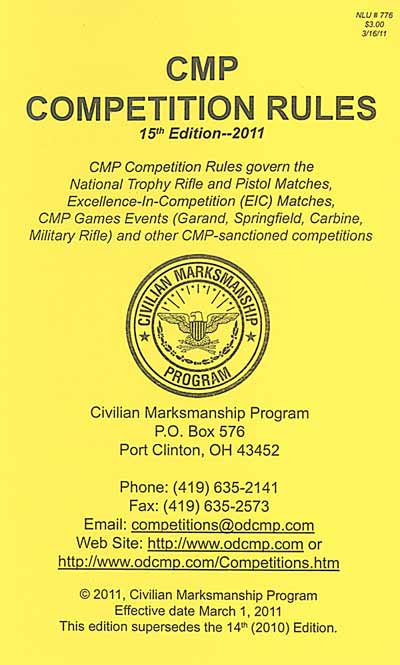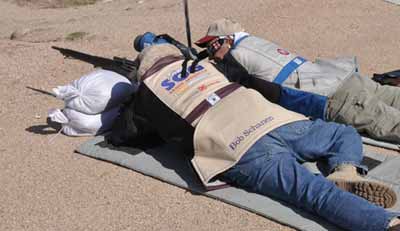2011 CMP Competition Rules Now Available New Vintage Sniper Rifle Team Match Introduced
By Gary Anderson, DCME
The 2011 15th edition of the CMP Competition Rules is now available. The CMP is the national governing body for Service Rifle, Service Pistol and CMP Games shooting events and the CMP Competition Rules is the official rulebook for these events that are a popular and important part of the national competitive shooting scene. The new rulebook is posted on the CMP website at
http://www.odcmp.com/Competitions/Rulebook.pdf.

The 2011 15th Edition CMP Competition Rules can now be downloaded from the CMP website at
http://www.odcmp.com/Competitions/Rulebook.pdf.
The most exciting new development in the 2011 rules is the addition of the Vintage Sniper Rifle Team Match. This match has already been tested with popular acclaim in the Eastern CMP Games twice and in the Western CMP Games once. This year, Vintage Sniper Rifle Team Matches will be fired at the Eastern CMP Games on 10 May, the National Matches on 3 August and the Western CMP Games on 18 October. In addition, any CMP-affiliated club that has 300 and 600 yard firing distances on their club range may now apply to conduct a Vintage Sniper Rifle Team Match as a CMP-sanctioned competition.
This match is for two-person teams. One team member acts as the firer while the other serves as a spotter. After the firer shoots ten shots at either the 300 or 600-yard distance, the two change roles to fire another ten shots. Each shooter fires a total of 20 shots and team rankings are based on their 40-shot totals.

Rules for the new Vintage Sniper Rifle Team Match for two-person teams are now available in the 2011 edition of the CMP Competition Rules.
All teams are required to use as-issued rifles that were designed and used for military sniping purposes in 1953 or earlier. Such storied rifles as the M1903A4, the M1C, M1D and a long list of foreign military sniper rifles are designated as legal rifles for this match. Competitors may fire either original rifles or replicas. Rule 6.4.3 provides full rules for the rifles and telescopes that may be used. This rule includes a Table with a complete list of legal sniper rifles and scopes. In cases where affordable original or replica optics may not be available, the Table lists certain non-issue scopes such as the Lyman Alaskan, Weaver K2.5 and K4 and Stith-Kollmorgen that may be used.
The firing procedure for this new match is designed to replicate the marksmanship challenges faced by military snipers who must engage difficult, long-range targets in a prone position during brief target exposures. All firing is done in the prone position where either a sling or a sandbag rest, but not both, may be used. Firing is done at 300 and 600 yards on the standard highpower rifle targets for those ranges. At each range, each team is given a five-minute sighter period. After that, shooter number one, is given ten 20-second target exposures, each followed by a 20-second scoring period when the targets are withdrawn. When the targets come back up, the spotter must check the location of the last shot, make a quick wind calculation that he communicates to the shooter and the shooter must fire the next shot—all within the 20-second exposure period. After both team members complete the 300-yard stage, they move to 600 yards to do the same thing.
One of the special challenges of this new match is the thrill that comes from using an historic military sniper rifle in competition conditions that hearken back to the days of the Korean or World Wars when military snipers were called upon to make extremely accurate long-range shots at targets which were exposed for just a few brief seconds. This match should turn out to be historical reenactment at its best.
The number of changes in the 2011 is probably the fewest to be introduced in one year since the CMP inherited rule-making authority from the U. S. Army and its regulations for Service Rifle And Service Pistol EIC and National Trophy Matches that were available through Army Regulation 920-30. Here is a summary of the changes in the 2011 CMP Competition Rules.
Eye and Hearing Protection, Rule 5.5.2. We’ve long taken for granted the importance of every person who works on the firing line or in the pits for a highpower rifle match having the good sense to wear adequate eye and hearing protection. CMP Rules have now taken this one step further by “strongly urging all competitors and competition officials to wear appropriate eye and hearing protection” on the line and in the pits.
Service Rifle Rear Sight Inserts, Rule 6.1.2 (3). The CMP approved two commercial rear sight inserts that serve as visual aids especially for older shooters for use in Service Rifle competitions. The rectangular rear aperture insert produced by ShootingSight LLC of Cincinatti, Ohio (http://www.shootingsight.com/) and the SR MicroSight produced by Stallings Machine of Senoia, Georgia (http://www.auburnscouts.com/stallingsmachine/index.htm) are now legal for use in CMP-sanctioned Service Rifle matches beginning with the 2011 shooting season.
M16A1 Pistol Grips, Rule 6.2.3 (10). The shorter M16A1 butt stock has been legal for years and has been used by many smaller shooters, but there was some confusion over whether the M16A1 pistol grip was legal. The answer has previously been no, it was not legal because the rules did not specifically authorize its use. That has changed in 2011 and the rules now permit the use of a M16A1 pistol grip that offers a slightly smaller grip.
Quad Rails on M16/ARs, Rule 6.2.3 (14). A fundamental concept in Service Rifle shooting is that competitors must use rifles commonly issued to military personnel and that are carried in combat. Since quad rails are now standard on M16s now issued to military personnel, M16/AR competition rifles will also be allowed to have quad rails. This authorization is limited to the standard 12-inch military quad rail or its commercial equivalent, the front sling swivel must still be attached to the front of the hand guard according to Rule 6.2.3 (9) and the standard A-frame front sight fixed in the as-issued position must still be used.
Bullet Button Magazine Locks (Rule 6.2.3 (15). California residents only are now authorized to use AR-type service rifles equipped with Bullet Button or similar magazine locks that replace the standard magazine catch.
Repaired Stocks, Rule, 6.3.1 (11). As-Issued Military Rifle shooters frequently have to deal with cracked or broken stocks. Under previous rules no glue, epoxy or synthetic substances could be used anywhere in the stock because of concerns over not allowing the use of epoxy or glass bedding. This restriction has now been modified so that shooters can use “epoxies or other chemical adhesives” to repair cracked or broken stocks as long and this material is not used to bed the action or barrel. At the National Matches and certain other matches, rifles used in As-Issued Military Rifle events are subject to post-match inspections where armorers remove the stock to check for illegal bedding.
.45 Cal. Pistols with Beavertail Safety Cuts, Rule 6.6, Table 2. The rules for service pistols now have a provision that pistols which have been modified to take beavertail safeties may still be used if the beavertails safety is replaced with an as-issued safety when the pistol is fired in a Service Pistol match. This is similar to the older rule that allows optical sight mount holes to be present on the slide. The purpose of both rules is to give many shooters with .45 cal. bulls-eye pistols the possibility of using those pistols in Service Pistol competitions.
Service Rifle Rapid-Fire Loading, Rule 8.1.5 (2). Loading procedures for Service Rifle rapid-fire shooting require competitors to start from the standing position with “bolts closed on empty chambers” and a magazine with two rounds inserted. The bolt may not be cycled to chamber the first round until the shooter is down in position after the targets come up. Prior to being given the commands to stand and load, competitors were in their preparation period where they were dry firing with bolts closed on empty chambers. Since all competitors must start their preparation periods with cleared rifles and ECIs inserted, many Service Rifle competitors have been standing to load with their bolts already closed on empty chambers. The new rules clarify that this is an acceptable procedure and that it is not necessary to open the bolts on these rifles and reclose them to load for rapid-fire.
Service Rifle Team Match Time Limits, Rules 8.4.3, 8.6.3 and 8.7.2. The 2011 rules clarify that the slow-fire pair firing time limits for the National Trophy Rifle Team Match (6 persons) are 66 minutes for 200-yard slow-fire and 126 minutes for 600-yard slow-fire. The time limits for the Hearst Doubles Team Match (2 persons) are 20 minutes for both the 200 and 600 yard stages. The time limits for the National Trophy Junior Team Match (2 persons) are 20 minutes at 200 yards and 40 minutes at 600 yards.
As usual, there are many other issues that were considered, but not adopted for this year’s rules. Many of these issues remain under consideration for possible future approval. Among them are 1) allowing any safe ammunition for Service Pistol competitions, 2) approving the M4 Carbine as a Service Rifle, 3) adding a vintage or as-issued pistol event to the CMP Games Matches, 4) permitting Service Rifle or Pistol competitors to alternatively fire their 4th EIC match, now restricted to the National Matches, at the Eastern or Western CMP Games, 5) adding a new shooter requirement for Police Service Pistol teams and 6) sanctioning additional 4-point EIC matches at the state level. Comments on any of these proposals are welcome and can be forwarded to CMP Headquarters at
competitions@odcmp.com.
The new rulebook is posted on the CMP website at
http://www.odcmp.com/Competitions/Rulebook.pdf or printed copies can be ordered from CMP Competitions for $3.00 each.
NEXT ARTICLE